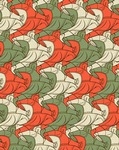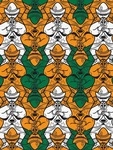The Tessellations of Nick Scalfittura
http://www.imagekind.com/GalleryProfile.aspx?gid=e44a9c26-5685-4112-8077-db54a090872d
Nick
Scalfittura’s tessellations are of a degree of magnitude above most other
people in the field, and indeed, I rate him most highly indeed, of the top
ranking. Although he attains just seven of the ten determining aspects of
ability and understanding of the issues, this apparent low marking is
misleading; indeed his work is one of noticeable quality, and is only due to
relatively few tessellations being shown, with criteria as listed in the
introduction:
(1) ✓The
inherent quality of the motif (silhouette and articulation)
(2) ✓Showing
the whole motif (excluding ‘heads’)
(3) ✓Excludes
‘breathing room’ tessellations
(4) x The number of tessellations in the
body of his work
(5) x Variety of motifs
(6) ✓A tendency to the more
difficult to achieve motifs
(7) ✓Coloured or shaded
tessellations (excluding wireframes)
(8) x Contrasting colouring of
tessellations
(9) ✓Finished rendering
(10)
✓Borderline
Pleasingly,
Scalfittura’s tessellations posses seven of the ten desired attributes. It can
be done; there is (tessellation) life after Escher…!
In
more detail:
(1) Recognisable in Silhouette
Pleasingly,
nearly all of Scalfittura’s eighteen tessellations are immediately recognisable
in silhouette. Indeed, there is only one of his oeuvre here that I can
question, Golfer. The articulation is quite superb. Some indication as
to quality is that in percentage terms, this is the highest ratio I have seen
17/18 (94%). This is quite stunning; no other artist remotely approaches this. Inferior
surface embellishment, the refuge of the inferior artist, is nowhere to be
seen.
The aspect of recognisably of the motif, as seen in
silhouette is fundamental to the premise of a quality tessellation. Lesser
artists struggle with this concept (inexplicably so, given its simple premise),
and fail to recognise its importance and unfortunately delude themselves as to
equating interior life–like interior detail surface detail with a exterior
outline that is articulated.
(2) Shows the Complete Motif
Scalfittura’s
tessellations, without exception, are of the more challenging type, namely of ‘complete,
whole bodied motif’ (like top tessellators Bailey, Bilney, Crompton, Escher,
Nakamura and Nicolas), in contrast to the inferior and easier to accomplish
amputation ‘head only’ type.
As a premise, the ‘head’ only type is excluded, as this
category is lacking in any challenge of worth, being all too easy. Lesser
artists frequently do not understand the difference between the two types, and
undertake such ‘head’ only examples (on account of their less
challenging aspect), and unfortunately delude themselves as to equating these
with the more challenging whole body motif.
(3)
Excludes ‘Pseudo’ Tessellations
Scalfittura’s
tessellations, without exception are of the higher moral ground ‘true’ type, without
gaps and overlaps (and so exclude easier to accomplish ‘pseudo’ types, the
latter being much beloved by inferior tessellators).
Lesser artists frequently include ‘pseudo’ types (on
account of their less challenging aspect), and unfortunately delude
themselves as to equating these with the more challenging ‘true’ type.
(4)
The Number of Tessellations
One
concern I have with Scalfittura’s tessellations is the relatively low number,
just 18. Ideally, I would like to see more, of which he is surely more than
capable. Strictly, I have to mark him down for this although I am loathe to do
so, given the outstanding quality. Quality is everything, sheer weight of
number counts for relatively little, although not to be ignored. Likely, he is
striving for quality, rather than just large numbers of run-of-the mill tessellations
of no particular merit.
Typically, lesser artists will show a large number of
inferior examples, and consider that such large numbers outweighs quality and
unfortunately delude themselves as to equating different aspects.
(5)
Variety of Motifs
Another
concern is a lack of variety, with just 7 different motifs, albeit that said I place
under a single human category some examples of which could be differentiated.
But even so, this would result in perhaps no more than 10 different motifs.
Again, strictly, I have to mark him down for this although I am loathe to do so,
given the outstanding quality.
Noteworthy is the complete lack of the simpler to achieve
birds and fish. Likely, he finds these too simple, and simply ignores them.
Lesser artists (of which he is not) frequently shy away
from undertaking variety, showing simpler to achieve birds and fish to the
exclusion of variety, and unfortunately delude themselves as to equating these
with the more praiseworthy variety of motifs.
(6)
Challenging Motifs – Human Figures
An
strength in his work are the human figures, in various guises, which are all
excellent, and on occasions quite superb, of which this forms a major role.
Indeed, he shows no less than 13 (72%), which is again outstanding in
percentage terms; no other artist approaches this. Although numerically this is
substantially much lower than Nakamura’s 70 (which to some extent is padded by
inferior examples, such as unnatural ‘bendy’ arms, arms without hands), these
are nearly of all inherent high quality throughout. When compared to Escher's
paltry 4, of at times questionable quality, this is worthy of the utmost
praise.
As such, the impression given by this is that human figures
are ‘easy’, on account of their relative frequency here. However, this is to
the contrary, as these are amongst the most difficult motifs to achieve.
As such, he must be purposefully striving for such motifs, of which aside from
the challenging aspect appeal on the human interest level.
Lesser artists frequently shy away from such examples (on
account of their challenging aspect), or when shown are best described as
mutants, with disjoint elements, such overly long arms or legs, or anatomical
inconsistencies, with the artist preferring the simpler to achieve birds and
fish.
(7) Coloured or Shaded Tessellations
These
are all shown coloured (like Bailey, Bilney, Crompton, Escher, and
Nakamura). No inferior ‘wireframe’ types are shown.
Lesser artists frequently show ‘wireframe’ examples, for no
good reason (from which one can only conclude is that they do not understand
the issues).
(8) Contrasting Colouring of Tessellations
Scalfittura’s
tessellations as a premise are coloured in contrasting colours. Although
overwhelmingly his tessellations show contrast, on a few occasions there is the
odd exception to this feature, where contiguous colours are used. For
example, Coffee Waiter, Chef, Dog with Newspaper, Surfer,
Republican-Democrat, Snake Charmer, Piper, Bear and
Bull 8/18 (44%), and so in percentage terms this is relatively high,
although that said, where conflicts occur, this is at a minimum. Again, strictly,
I have to mark him down for this, although I am loathe to do so given the
outstanding quality.
Lesser artists (of which he is not) frequently show ‘no
contrast’ examples, for no good reason (from which one can only conclude is
that they do not understand the issues).
(9) Finished Rendering
Scalfittura’s
style, as regards finish, is of a consistent manner throughout, favouring a
degree of detail level as espoused by Escher, where the motifs are portrayed in
a simplified manner, without excessive detail. These are all computer rendered
(rather than hand-drawn), to a very pleasing, high quality standard. As such,
he strikes the ideal balance between too simple (although this has its
strengths) and too detailed. As a rule, generally a simplistic finish is to be
preferred (as here), as too much detail hinders a clear interpretation of the
motif.
Lesser artists sometimes render the motifs in too much
detail, believing this to be superior to a more simplistic rendering.
(10)
Borderline
Scalfittura
always adds a borderline, either of unit thickness, or slightly more pronounced.
Generally, strong colours are used that don’t strictly require a borderline.
Even so, even in such instances, he nonetheless uses this feature.
However, the omission of a borderline cannot be said to be
a fault as such, in that the inclusion or exclusion is down to personal choice,
depending on the circumstances of the tessellation. Undoubtedly, this is
secondary to the tessellation itself, and so of less importance to other, more
fundamental issues, as detailed above.
Lesser artists invariably omit this feature, not
understanding the reasons for its general desirability, namely that of aid in
discerning the motifs.
General
Comments:
Positives
Scalfittura,
in contrast to most other tessellators, has many tessellations of good or
excellent quality that are deserving of the utmost praise. The all-important
aspect of being recognisable in silhouette extends to mostly his entire work.
Indeed, only one (Golfer) fails this test. Not only are these recognisable is
silhouette, but their articulation is invariably very good indeed. In
particular, his human figures are very good. Furthermore, his motifs do not
have just the single, most typical viewpoint, but strike different poses
(typically of an ‘action’ pose, such as leaping), all the while retaining their
inherent quality. Note that many have true articulation, in that the head,
body, arms (and ideally hands), and legs (and ideally feet) are readily
discernable. Contrast this attention to detail with other people’s human
figures which lack this, which are generally wholly surface embellishment.
Pleasingly, many of his tessellations are of a themed
nature, in that the motifs have a natural confluence to each other:
(1) Coffee waiter (waiter at table with coffee being
served, and holding cheeseboard)
(2) Chef (chef with hat, soup tureen and pan)
(3 Knight (knight in armour, with sword held aloft)
(5) Waiter (waiter, with food being served)
(7) Dog with newspaper (dog and paper in mouth)
(8) Surfer (surfer with surfboard striking a typical
pose, of bended knees),
(9) Spartan (Spartan gladiator, with sword and shield)
(10) Snake charmer (snake charmer with snake rising from basket),
(17) Businessman (business man with newspaper),
(12) Superhero (superhero, in typical elongated flying pose
(18) Santa Claus (Santa Claus with sack and pudding).
Others
are opposites, such as:
(10) Republican-Democrat (elephants and donkeys)
(16) Bear and Bull (in allusion to the stock market)
Likely,
he must be striving for such confluences. In contrast, other tessellators have
enough trouble coming up with any two motifs, never mind with
confluences. Inferior artists often have to accept their motifs with disjoint
features that bear no relation to the motif e.g. a dog carrying a box on its
back, which obviously lacks any unifying feature. No such artifice is found in
his work. A feature throughout is a natural confluence of the individual
motifs, with the motifs possessing all the elements or accoutrements (e.g. Knight,
with sword, Spartan with shield. Again, such attention to what might at
first thought be petty detail simply adds to the inherent quality of the
tessellation. Say if a hand can be articulated, then make it so, rather than
just surface embellishment, as favoured by lesser artists.
Although nearly all are of a high standard, some are worth
singling out in particular, of which I detail below:
A highlight, described as a superlative, is that of the ‘restaurant’
theme, featuring waiters and chefs (Coffee Waiter, Chef, Waiter, shown below).
These are quite superb, and of a type that no-one else has done before. As a
concept, such a pose is fraught with difficulty to accomplish to a satisfactory
degree, of which these remain of the highest standards of the art.
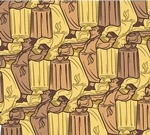
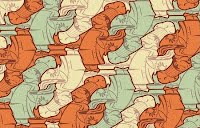
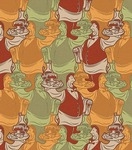
Very good are his other various human figures. The
articulation on the examples below is most impressive. Highlights include Knight,
Surfer, Spartan, Piper, Santa Claus.
Negatives
As
such, I struggle to find any negatives! Even the one I have reservations
about, Golfer, one can make a case for acceptability. Certainly, there is a lack of variety, with just 7
different motifs, and relatively few tessellations, just 18. However, the sheer quality overrides this. Aside from the relative shortcomings above though, I can
find very little to fault here. Indeed, one could be accused of cavilling with
the above comments – most other artists would be more than pleased with the one
I cavil with here.
Escher
Comparison
Is
he better than Escher? In this instance, direct comparisons are not easy, in
that these artists present their tessellations differently. For example, Escher
has more in number, but some are unworthy. Scalfittura has fewer, but shows
none unworthy. Scalfittura completes ignores the easier birds and fish, whereas
Escher didn’t. Therefore, to decide who’s best is not straightforward. My
concern is with quality, not number. Can I say it… dare I say it, but I
consider his tessellations are better. (Although the examinations below show parity.)
Mostly
better in the ‘silhouette test’ with Escher
Fewer
numbers of tessellations with Escher (Escher’s 137 being padded to some extent,
whilst Scalfittura’s 18 are not), of generally comparable quality, indeed if
not better
Less
variety of motifs with Escher, 32 against 7
More
challenging motifs (i.e. human figures) than Escher, 13 against 4
As can be seen, by the simple comparison above, they are
more or less on a par. However, I put more weight on the quality issue, of
which these are quite superb, outscoring Escher. Admittedly, sheer number and
variety play a part (Escher’s strong points), but underlying this is the
quality issue.
Admittedly, Escher was, to all intents and purposes, the
first tessellator (negating Koloman Moser’s examples), and so all the kudos of
inventing/discovering a new type of art from is worthy of the utmost praise.
Indeed, without Escher, how many people, including Scalfittura, would have the
wit and invention to do this? Probably none. Therefore, Escher stands alone here.
However, that said, why should the person who makes the breakthrough in a
certain field be regarded as having the field to himself, with other people’s
contributions neglected or ignored? As Escher himself stated, he himself opened
the garden gate of tessellation, and wandered around. Other people of a like mind have now followed
him through, some, but not many, with innovations of their own to contribute.
Escher did not do everything.
Summary
Scalfittura
is a very exceptional, if not superb tessellator, and certainly one of the
finest, with his tessellations occasionally being of a superlative nature, for
example the ‘restaurant’ theme, featuring waiters and chefs (Coffee Waiter,
Chef, Waiter). These are quite outstanding, are innovative, and
worthy of the highest praise. Many others are worthy of praise, for example Knight,
and Dog with Newspaper.
Even when quite not of the highest standards, then these
are still generally of a much higher quality than with other people. As
detailed above, he understands the various issues underpinning the composing of
inherent quality of tessellations. Furthermore, he introduces some innovations
of his own, such as a Knight, Dog with Newspaper, Surfer, Spartan,
Snake Charmer, Bear and Bull, these as a motif type not been seen
in others work. Also, he concentrates on motifs of a high quality that are
difficult to achieve (human figures). Indeed, this in percentage terms is by
far the highest, 13/18 (72%). Again, worthy of the highest praise.
That said, although I praise him wholeheartedly, I place
him below Nakamura. Simply stated, Nakamura outscores him, in different ways; by greater numbers
of comparable quality, more superlatives, more different motifs, more human
figures.
|
Table of Distinct Motifs of Nick Scalfittura
|
|
Motif
|
Frequency
|
|
Waiter/Chef
|
3
|
|
Knight
|
1
|
|
Surfer
|
1
|
|
Golfer
|
1
|
|
Spartan
|
1
|
|
Snake Charmer
|
1
|
|
Piper
|
1
|
|
Superhero
|
1
|
|
Businessman
|
1
|
|
Santa Claus
|
1
|
|
Devil
|
1
|
|
Raptor
|
1
|
|
Dogs
|
2
|
|
Elephant & Donkey
|
1
|
|
Bear & Bull
|
1
|
|
Table of Escher-Like Tessellations
by Nick
Scalfittura
|
|
Number
|
Motif
|
Borderline
|
|
1
|
Coffee Waiter
|
Yes
|
|
2
|
Chef
|
Yes
|
|
3
|
Knight
|
Yes
|
|
4
|
Devil
|
Yes, unit thickness
|
|
5
|
Waiter
|
Yes, unit thickness
|
|
6
|
Raptor
|
Yes, unit thickness
|
|
7
|
Dog with Newspaper
|
Yes
|
|
8
|
Surfer
|
Yes
|
|
9
|
Golfer
|
Yes, unit thickness
|
|
10
|
Republican-Democrat
|
Yes
|
|
11
|
Spartan
|
Yes, unit thickness
|
|
12
|
Snake charmer
|
Yes, unit thickness
|
|
13
|
Piper
|
Yes
|
|
14
|
Superhero
|
Yes, unit thickness
|
|
15
|
Dogs
|
Yes, unit thickness
|
|
16
|
Bear and Bull
|
Yes
|
|
17
|
Businessmen
|
Yes, unit thickness
|
|
18
|
Santa Claus
|
Yes
|
Created:
15 September 2010




